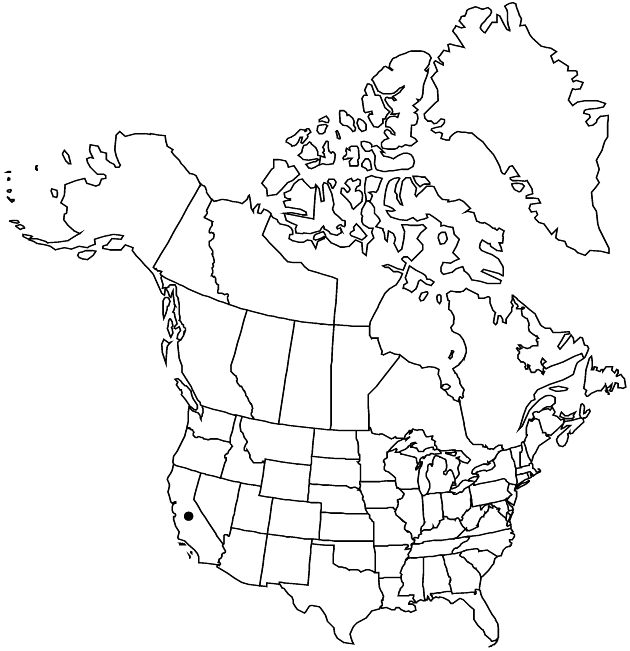Difference between revisions of "Packera ionophylla"
Phytologia 49: 47. 1981.
FNA>Volume Importer |
imported>Volume Importer |
||
| (5 intermediate revisions by 2 users not shown) | |||
| Line 8: | Line 8: | ||
}} | }} | ||
|common_names=Tehachapi ragwort | |common_names=Tehachapi ragwort | ||
| − | |basionyms={{Treatment/ID/ | + | |special_status={{Treatment/ID/Special_status |
| + | |code=E | ||
| + | |label=Endemic | ||
| + | }}{{Treatment/ID/Special_status | ||
| + | |code=C | ||
| + | |label=Conservation concern | ||
| + | }} | ||
| + | |basionyms={{Treatment/ID/Basionym | ||
|name=Senecio ionophyllus | |name=Senecio ionophyllus | ||
|authority=Greene | |authority=Greene | ||
| + | |rank=species | ||
| + | |publication_title=Pittonia | ||
| + | |publication_place=2: 20. 1889 | ||
}} | }} | ||
|synonyms={{Treatment/ID/Synonym | |synonyms={{Treatment/ID/Synonym | ||
|name=Senecio ionophyllus var. intrepidus | |name=Senecio ionophyllus var. intrepidus | ||
|authority=Greenman | |authority=Greenman | ||
| + | |rank=variety | ||
}} | }} | ||
|hierarchy=Asteraceae;Asteraceae tribe Senecioneae;Packera;Packera ionophylla | |hierarchy=Asteraceae;Asteraceae tribe Senecioneae;Packera;Packera ionophylla | ||
| Line 40: | Line 51: | ||
-->{{#Taxon: | -->{{#Taxon: | ||
name=Packera ionophylla | name=Packera ionophylla | ||
| − | |||
|authority=(Greene) W. A. Weber & Á. Löve | |authority=(Greene) W. A. Weber & Á. Löve | ||
|rank=species | |rank=species | ||
| Line 54: | Line 64: | ||
|publication title=Phytologia | |publication title=Phytologia | ||
|publication year=1981 | |publication year=1981 | ||
| − | |special status= | + | |special status=Endemic;Conservation concern |
| − | |source xml=https:// | + | |source xml=https://bitbucket.org/aafc-mbb/fna-data-curation/src/2e0870ddd59836b60bcf96646a41e87ea5a5943a/coarse_grained_fna_xml/V19-20-21/V20_1317.xml |
|tribe=Asteraceae tribe Senecioneae | |tribe=Asteraceae tribe Senecioneae | ||
|genus=Packera | |genus=Packera | ||
Latest revision as of 20:00, 5 November 2020
Perennials, 15–30+ cm; taprooted (caudices erect) or rhizomatous (rhizomes branched). Stems usually 1, rarely 2–3, clustered, irregularly arachnoid-tomentose to lanate-tomentose or glabrescent. Basal leaves (and proximal cauline, relatively turgid) petiolate; blades broadly ovate or lyrate (± pinnately lobed, lateral lobes 1–3 pairs, smaller than terminals), 10–30+ × 10–20+ mm, bases tapering to cuneate, ultimate margins subentire or crenate to coarsely dentate (abaxial faces tomentose). Cauline leaves gradually reduced (sessile; bractlike, entire). Heads 3–6 in cymiform arrays. Peduncles bracteate, irregularly tomentose. Calyculi inconspicuous. Phyllaries (8–)13 or 21, green, 7–10+ mm, densely tomentose proximally, glabrescent distally (tips hair-tufted). Ray florets 8–13; corolla laminae 8–10 mm. Disc florets 60–75+; corolla tubes 2.5–4 mm, limbs 3.5–5 mm. Cypselae 2–2.5 mm, glabrous; pappi 5–7 mm. 2n = 46.
Phenology: Flowering early Jun–late Aug.
Habitat: Dry, rocky slopes, crevices, granitic outcrops, coniferous woodlands
Elevation: 1400–3000 m
Discussion
Of conservation concern.
Packera ionophylla is known only from the San Bernardino, San Gabriel, and Tehachapi mountains and a population on Alamo Mountain in eastern Ventura County.
Selected References
None.
